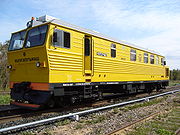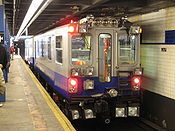
Track geometry car
Encyclopedia


History
By at least 1967, geometry cars had emerged. One of the earliest was Car T2 used by the U.S. Department of Transportation's Project HISTEP (High-Speed Train Evaluation Program). It was built by the Budd CompanyBudd Company
The Budd Company is a metal fabricator and major supplier of body components to the automobile industry, and was formerly a manufacturer of stainless steel passenger rail cars during the 20th century....
especially for Project HISTEP to evaluate track conditions between Trenton and New Brunswick, NJ, where the DOT had established a section of track for testing high-speed trains, and accordingly, the T2 ran at or greater than 150 miles per hour.Many of the first regular service geometry cars were created from old passenger cars outfitted with the appropriate sensors, instruments, and recording equipment; they were then coupled behind a locomotive. By at least 1977, self-propelled geometry cars had emerged. Southern Pacific's GC-1 (built by Plasser American) was among the first and utilized twelve measuring wheels in conjunction with strain gauges, computers, and spreadsheets to give managers a clear picture of the condition of the railroad. Even in 1981, the Encyclopedia of North American Railroads considered this the most advanced track geometry car in North America.
Advantages
Track inspection was originally done by track inspectors walking the railroad and visually inspecting every section of track. This was hazardous as it had to be done while trains were running. It was also manpower intensive, and inspectors were limited in the amount of track they could inspect on a given day. Manual instruments had to be used to measure various parameters of the track.The primary benefits of track geometry cars are the time and labor saved when compared to doing manual inspections of track. Track geometry cars may travel up to 217 miles per hour (335 kilometers per hour), inspecting track the whole time. More commonly, on freight railroads, geometry cars travel at track speed (up to seventy miles per hour) in order to minimize service disruptions. Current track geometry cars may cover large portions of the system in a single day. Many times, maintenance gangs will follow the geometry car and fix defects as the geometry car moves along the track.
Because track geometry cars are full-sized rail cars (with the exception of some lighter hi-rail geometry cars), track geometry cars also provide a better picture of the geometry of the track under loading (when compared to the manual methods which did not take this into account). Finally, track geometry data is generally stored and can be used to track trends in the degradation of track. This data can be used to pinpoint and predict trouble spots in the track and plan maintenance programs accordingly.
Parameters measured
The tolerances of each parameter varies by the Track class of the track being measured. In the United States, geometry cars generally classify each defect as either "Class II" or "Class I" (though the exact name may vary by the railroad). A class II defect is known as a maintenance level defect, meaning that the track doesn't meet a particular railroad's own standards. Each railroad has their own standard for a maintenance level defect. A class I defect is a defect in violation of the Federal Railroad Administration's (FRA) track safety standards. Railroads must fix these defects within a certain period of time after their discovery or else they risk being fined.- Alignment - "Alignment is the projection of the track geometry of each rail or the track center line onto the horizontal plane," (FRA Definition). Also known as the "straightness" of the tracks.
- Crosslevel - The variation in cantCant (road/rail)The cant of a railway track or a road is the difference in elevation between the two edges...
of the track over the length of a predetermined "chord" length (generally sixty-two feet). On straight or tangent track, ideally there should be no variation, while on curves, a cant is generally desired. - CurvatureCurvatureIn mathematics, curvature refers to any of a number of loosely related concepts in different areas of geometry. Intuitively, curvature is the amount by which a geometric object deviates from being flat, or straight in the case of a line, but this is defined in different ways depending on the context...
- The amount by which the rail deviates from being straight or tangent. The geometry car checks the actual curvature (in Degree of curvatureDegree of curvatureDegree of curve or degree of curvature is a measure of curvature of a circular arc used in civil engineering for its easy use in layout surveying....
) of a curve versus its design curvature. - Overhead linesOverhead linesOverhead lines or overhead wires are used to transmit electrical energy to trams, trolleybuses or trains at a distance from the energy supply point...
(or catenary) - Measures the height and stagger of contact wire, the position of catenary masts or poles, and the positions of the wire bridges if applicable. - Rail gaugeRail gaugeTrack gauge or rail gauge is the distance between the inner sides of the heads of the two load bearing rails that make up a single railway line. Sixty percent of the world's railways use a standard gauge of . Wider gauges are called broad gauge; smaller gauges, narrow gauge. Break-of-gauge refers...
- The distance between the rails. Over time, rail may become too wide or too narrow. In North America and most of the world, standard gauge is 4 feet, 8.5 inches. - Rail profileRail profileThe rail profile is the cross sectional shape of a railway rail, perpendicular to the length of the rail.In all but very early cast iron rails, a rail is hot rolled steel of a specific cross sectional profile designed for use as the fundamental component of railway track.Unlike some other uses of...
- Looks for rail wear and deviations from standard profile. - Warp - The maximum change in crosslevel over a predetermined chord length (generally sixty-two feet).
Technologies utilized
Track geometry cars use a variety of technologies to inspect the track and manage the large amounts of data being collected by them. Today most geometry cars use computers to process and display data gathered by the systems. Older geometry cars produced long spreadsheets worth of data or stored the data on magnetic tapes.Non-contact measurement and inspection methods
- Laser Measurement Systems - Measures Rail profileRail profileThe rail profile is the cross sectional shape of a railway rail, perpendicular to the length of the rail.In all but very early cast iron rails, a rail is hot rolled steel of a specific cross sectional profile designed for use as the fundamental component of railway track.Unlike some other uses of...
and wear, crosslevel, and Rail gaugeRail gaugeTrack gauge or rail gauge is the distance between the inner sides of the heads of the two load bearing rails that make up a single railway line. Sixty percent of the world's railways use a standard gauge of . Wider gauges are called broad gauge; smaller gauges, narrow gauge. Break-of-gauge refers... - Accelerometers
- Used measuring measure alignment by finding the acceleration in a certain direction and then integrating until a position is obtained. These positions are then used to create artificial chords to measure various several parameters.
- Used to obtain ride quality measurements. If certain accelerations are reached or exceeded freight can be damaged or passengers may become uncomfortable.
- Video System - Captures video of the right-of-way for further analysis, as well as for Machine visionMachine visionMachine vision is the process of applying a range of technologies and methods to provide imaging-based automatic inspection, process control and robot guidance in industrial applications. While the scope of MV is broad and a comprehensive definition is difficult to distil, a "generally accepted...
inspections of certain track components - Gyroscope - Oriented in the vertical direction, used to measure cross level and warp. These are now obsolete, having been replaced by laser measurement systems.
- Proximity SensorProximity sensorA proximity sensor is a sensor able to detect the presence of nearby objects without any physical contact.A proximity sensor often emits an electromagnetic or a beam of electromagnetic radiation , and looks for changes in the field or return signal. The object being sensed is often referred to as...
- Used to measure surfaces, alignment, and gauge. These are now obsolete, having been replaced by laser measurement systems.
Contact measurement and inspection methods
- Measuring Wheels - Mostly obsolete, originally used for measuring nearly all parameters, these have now been replaced by lasers
- Strain Gauges - Used in conjunction with the measuring wheels to translate the various movements of the measuring wheels into a usable format
Other technologies utilized
- Global Positioning SystemGlobal Positioning SystemThe Global Positioning System is a space-based global navigation satellite system that provides location and time information in all weather, anywhere on or near the Earth, where there is an unobstructed line of sight to four or more GPS satellites...
- Tracks the progress of the geometry car and provides the exact location of defects found by the geometry car. The coordinates of a defect are generally forwarded to a roadmaster or track inspector who can use them to pinpoint defects once found. - Paint Spray System - Marks the location of a defect on the track once a defect is found.
Regulatory compliance in the United States
In the United States, the Federal Railroad AdministrationFederal Railroad Administration
The Federal Railroad Administration is an agency in the United States Department of Transportation. The agency was created by the Department of Transportation Act of 1966...
(FRA) maintains a fleet of three geometry cars as part of its Automated Track Inspection Program (ATIP). The FRA runs its fleet of geometry cars around the country to check railroads for compliance with their track safety standards. According to the FRA, their geometry cars travel approximately 30,000 miles and find approximately 10,000 defects every year, which are then fixed by the railroads.
Future
In the United States, railroads are looking into new ways to measure geometry that cause even less interference to train operations. The Transportation Technology Center, Inc. (TTCI) in Pueblo, CO has been conducting tests using a portable ride quality monitoring system attached to a standard freight car. TTCI has also been promoting a move to "Performance Based Track Geometry" or PBTG. Most current track geometry systems only look at the condition of the track itself, while a PBTG system also looks at vehicle dynamics caused by track conditions.Examples
- SNCF TGV Iris 320SNCF TGV Iris 320
Iris 320 is a modified TGV train operated by SNCF International as a dedicated track recording train for high-speed railways. The train can run at 320 kilometres-per-hour and consists of two power cars and eight trailers coaches providing 160 metres of laboratory space...
- ICE S - Doctor Yellow
Doctor Yellow
is the nickname for the high-speed test trains that are used on the Japanese Shinkansen dedicated express passenger train routes.The trains have special equipment on board to monitor the condition of the track and overhead wire, including special instrumented bogies and observation blisters.The...
- New Measurement Train, British Rail Class 950
British Rail Class 950
The British Rail Class 950 is a diesel multiple unit that was purpose-built for departmental use as a track assessment unit. It was built in 1987 using the same bodyshell as the Class 150/1 "Sprinter" units that were built from 1985-1986....
External links
- Federal Railroad Administration - Automated Track Inspection Program (ATIP)
- Transportation Technology Center, Inc. (TTCI)
- Southern Pacific's Track Geometry Car GC-1
- Example Track Geometry Data - Taken after the 2008 Chatsworth train collision2008 Chatsworth train collisionThe Chatsworth train collision occurred at 16:22 PDT on Friday September 12, 2008, when a Union Pacific freight train and a Metrolink commuter train collided head-on in the Chatsworth district of Los Angeles, California, in the United States...

